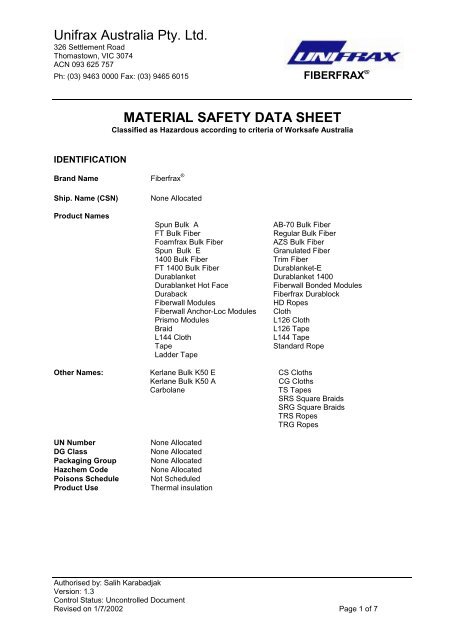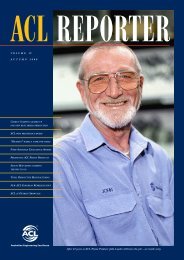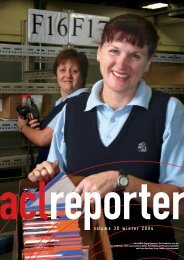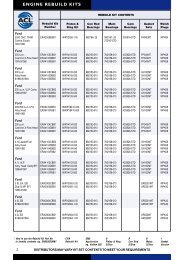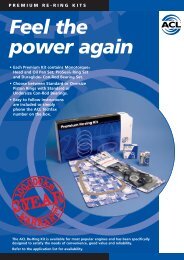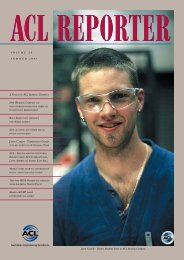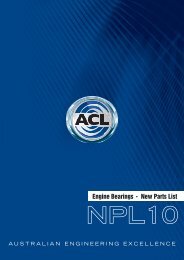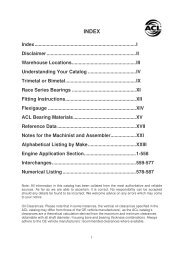Unifrax Australia Pty Ltd MATERIAL SAFETY DATA SHEET
Unifrax Australia Pty. Ltd. MATERIAL SAFETY DATA SHEET - ACL
Unifrax Australia Pty. Ltd. MATERIAL SAFETY DATA SHEET - ACL
- No tags were found...
Create successful ePaper yourself
Turn your PDF publications into a flip-book with our unique Google optimized e-Paper software.
<strong>Unifrax</strong> <strong>Australia</strong> <strong>Pty</strong>. <strong>Ltd</strong>.<br />
326 Settlement Road<br />
Thomastown, VIC 3074<br />
ACN 093 625 757<br />
Ph: (03) 9463 0000 Fax: (03) 9465 6015 FIBERFRAX ®<br />
<strong>MATERIAL</strong> <strong>SAFETY</strong> <strong>DATA</strong> <strong>SHEET</strong><br />
Classified as Hazardous according to criteria of Worksafe <strong>Australia</strong><br />
IDENTIFICATION<br />
Brand Name Fiberfrax ®<br />
Ship. Name (CSN)<br />
Product Names<br />
None Allocated<br />
Spun Bulk A<br />
AB-70 Bulk Fiber<br />
FT Bulk Fiber<br />
Regular Bulk Fiber<br />
Foamfrax Bulk Fiber<br />
AZS Bulk Fiber<br />
Spun Bulk E<br />
Granulated Fiber<br />
1400 Bulk Fiber Trim Fiber<br />
FT 1400 Bulk Fiber<br />
Durablanket-E<br />
Durablanket Durablanket 1400<br />
Durablanket Hot Face<br />
Fiberwall Bonded Modules<br />
Duraback<br />
Fiberfrax Durablock<br />
Fiberwall Modules<br />
HD Ropes<br />
Fiberwall Anchor-Loc Modules Cloth<br />
Prismo Modules<br />
L126 Cloth<br />
Braid<br />
L126 Tape<br />
L144 Cloth<br />
L144 Tape<br />
Tape<br />
Standard Rope<br />
Ladder Tape<br />
Other Names: Kerlane Bulk K50 E CS Cloths<br />
Kerlane Bulk K50 A<br />
CG Cloths<br />
Carbolane<br />
TS Tapes<br />
SRS Square Braids<br />
SRG Square Braids<br />
TRS Ropes<br />
TRG Ropes<br />
UN Number<br />
DG Class<br />
Packaging Group<br />
Hazchem Code<br />
Poisons Schedule<br />
Product Use<br />
None Allocated<br />
None Allocated<br />
None Allocated<br />
None Allocated<br />
Not Scheduled<br />
Thermal insulation<br />
Authorised by: Salih Karabadjak<br />
Version: 1.3<br />
Control Status: Uncontrolled Document<br />
Revised on 1/7/2002 Page 1 of 7
<strong>Unifrax</strong> <strong>Australia</strong> <strong>Pty</strong>. <strong>Ltd</strong>.<br />
326 Settlement Road<br />
Thomastown, VIC 3074<br />
ACN 093 625 757<br />
Ph: (03) 9463 0000 Fax: (03) 9465 6015 FIBERFRAX ®<br />
Physical Data<br />
<strong>MATERIAL</strong> <strong>SAFETY</strong> <strong>DATA</strong> <strong>SHEET</strong><br />
Classified as Hazardous according to criteria of Worksafe <strong>Australia</strong><br />
Appearance<br />
White fibrous material - Nil odour<br />
Melting Point<br />
1760 o C<br />
Boiling Point<br />
Not applicable<br />
Vapour Pressure Not applicable<br />
Specific Gravity 2.62<br />
Flash Point<br />
None<br />
Flamm. Limit LEL Not applicable<br />
Solubility in Water Not available<br />
Other Properties<br />
Autoignition Temp.<br />
Vapour Density<br />
pH Value<br />
Ingredients<br />
Information on<br />
Composition<br />
Other Information<br />
None<br />
Not applicable<br />
Not applicable<br />
Name CAS Proportion<br />
Ceramic Fiber 65997-17-3 99-100%<br />
Refractory Fiber<br />
Ceramic Fiber<br />
MMVF<br />
SMF<br />
Remaining components not determined to be hazardous and/or hazardous<br />
components present at less than 1.0% (0.1% for carcinogens).<br />
HEALTH HAZARD INFORMATION<br />
Health Effects<br />
Acute - Ingestion<br />
Acute - Eye<br />
Acute - Skin<br />
Acute - Inhalation<br />
Chronic<br />
If ingested in sufficient quantity it may cause temporary irritation and<br />
gastrointestinal disturbances.<br />
Physical irritation. Abrasive action may cause damage to the outer surface<br />
of the eye.<br />
May cause physical irritation and inflammation due to mechanical reaction to<br />
sharp, broken ends of Fibers.<br />
Irritation or soreness in throat, nose and upper respiratory tract.<br />
Refer to 'OTHER INFORMATION - Toxicology'.<br />
First Aid<br />
Authorised by: Salih Karabadjak<br />
Version: 1.3<br />
Control Status: Uncontrolled Document<br />
Revised on 1/7/2002 Page 2 of 7
<strong>Unifrax</strong> <strong>Australia</strong> <strong>Pty</strong>. <strong>Ltd</strong>.<br />
326 Settlement Road<br />
Thomastown, VIC 3074<br />
ACN 093 625 757<br />
Ph: (03) 9463 0000 Fax: (03) 9465 6015 FIBERFRAX ®<br />
<strong>MATERIAL</strong> <strong>SAFETY</strong> <strong>DATA</strong> <strong>SHEET</strong><br />
Classified as Hazardous according to criteria of Worksafe <strong>Australia</strong><br />
Ingestion<br />
Eye<br />
Skin<br />
Inhalation<br />
Do not induce vomiting; drink plenty of water.<br />
Flush immediately with large amounts of water for at least 15 minutes.<br />
Eyelids should be held away from the eyeball to ensure thorough rinsing. Do<br />
not rub eyes.<br />
If skin becomes irritated, remove contaminated clothing. Wash area of<br />
contact thoroughly with soap and water. Do not rub or scratch exposed skin.<br />
Using a skin cream or lotion after washing may be helpful.<br />
Remove exposed person/s from source of exposure, to fresh air.<br />
Advice to Doctor<br />
Acute effects are essential irritant in nature. Refer to 'OTHER<br />
INFORMATION' section for long term exposures.<br />
OTHER HEALTH HAZARDOUS INFORMATION<br />
Precautions for Use<br />
Exposure Limits<br />
Other Exposure Info.<br />
Engineering Controls<br />
0.5 Fiber/ml for synthetic mineral Fiber.<br />
As published by Worksafe <strong>Australia</strong>.<br />
Where possible use engineering controls such as exhaust ventilation and<br />
dust collection devices to reduce airborne Fiber levels.<br />
Personal Protection<br />
Protective Equipment<br />
The National Code of Practice for the Safe Use of Synthetic Mineral Fibers<br />
(NOHSC May 1990) advises that for installation and removal of both bonded<br />
and unbonded ceramic Fiber material the following personal protective<br />
equipment should be used.<br />
(a) Disposable coveralls or long sleeve, loose fitting clothing and gloves<br />
(launderable clothing should be washed separately from other clothing).<br />
(b) Where overhead work is involved, goggles and head covering should be<br />
worn; and<br />
(c) A half-face (P1 or P2) respirator should be worn during work in enclosed<br />
or poorly ventilated spaces, for example, in ceiling spaces, or where<br />
evidence suggests that respirable Fiber levels may exceed 0.5 f/ml.<br />
For ceramic Fiber removal work the following personal protective equipment<br />
should be used.<br />
(a)<br />
Disposable coveralls or long sleeves, loose fitting clothing and gloves be<br />
worn during installation (launderable clothing should be washed<br />
Authorised by: Salih Karabadjak<br />
Version: 1.3<br />
Control Status: Uncontrolled Document<br />
Revised on 1/7/2002 Page 3 of 7
<strong>Unifrax</strong> <strong>Australia</strong> <strong>Pty</strong>. <strong>Ltd</strong>.<br />
326 Settlement Road<br />
Thomastown, VIC 3074<br />
ACN 093 625 757<br />
Ph: (03) 9463 0000 Fax: (03) 9465 6015 FIBERFRAX ®<br />
<strong>MATERIAL</strong> <strong>SAFETY</strong> <strong>DATA</strong> <strong>SHEET</strong><br />
Classified as Hazardous according to criteria of Worksafe <strong>Australia</strong><br />
(b)<br />
(c)<br />
separately from other clothing).<br />
Where overhead work is involved, goggles and head covering should be<br />
worn; and<br />
A half-face respirator (Class P1 or P2) respirator.<br />
For removal of embrittled or heat effected ceramic materials, the following<br />
personal protective equipment should be used by all personnel directly<br />
involved in the removal work.<br />
(a)<br />
(b)<br />
(c)<br />
Disposable coveralls or long sleeve, loose fitting clothing and gloves<br />
(launderable clothing should be washed separately from other clothing).<br />
Where overhead work is involved, goggles and head covering should be<br />
worn. Eye protection would be provided as an integral component of a<br />
full-face respirator.<br />
A Class P2 respirator provides the necessary protection factor for this<br />
task. However, in some circumstances where excessive levels of dust<br />
are created, the limitations of filter loading capacity and facial seal may<br />
necessitate the use of:<br />
• a full (P3) cartridge respirator, or<br />
• a full (P3) powered air-purifying respirator or<br />
• a full faced, positive pressure demand airline respirator.<br />
Flammability<br />
Fire Hazards<br />
All respiratory protective devices should comply with AS/NZS1715 and<br />
AS/NZS1716.<br />
Non flammable<br />
SAFE HANDLING INFORMATION<br />
Storage and Transport<br />
Storage Precautions<br />
Handling<br />
No special transport or storage requirements are necessary.<br />
In the installation of unbonded materials, the following handling and<br />
installation procedures are recommended.<br />
(a) All installation practices should be designed to minimise the liberation of<br />
any airborne Fiber or dust.<br />
(b) In large installations of several days/weeks duration, the installation area<br />
should be clearly designated and barriers erected to prevent access.<br />
(c)<br />
(d)<br />
The ceramic materials should be stored in sealed plastic bags or similar<br />
containers until installation is to proceed. These containers should only<br />
be opened within the designated work area when work is to start.<br />
Where possible, materials should be delivered in sizes such that a<br />
minimum of handling and machining is required. However, when cutting<br />
or drilling is required, these should be done with hand tools fitted with<br />
local exhaust extraction. The exhaust from such extraction equipment<br />
Authorised by: Salih Karabadjak<br />
Version: 1.3<br />
Control Status: Uncontrolled Document<br />
Revised on 1/7/2002 Page 4 of 7
<strong>Unifrax</strong> <strong>Australia</strong> <strong>Pty</strong>. <strong>Ltd</strong>.<br />
326 Settlement Road<br />
Thomastown, VIC 3074<br />
ACN 093 625 757<br />
Ph: (03) 9463 0000 Fax: (03) 9465 6015 FIBERFRAX ®<br />
<strong>MATERIAL</strong> <strong>SAFETY</strong> <strong>DATA</strong> <strong>SHEET</strong><br />
Classified as Hazardous according to criteria of Worksafe <strong>Australia</strong><br />
(e)<br />
(f)<br />
should be fitted and positioned away from other work areas.<br />
Empty storage bags should be folded and stored in a waste container<br />
along with any other waste material.<br />
Upon completion of the job, all excess material should be sealed in bags<br />
prior to removal from the designated work area. The work area should<br />
be vacuumed using an industrial vacuum cleaner. Wet mopping and<br />
wiping can be utilised if an industrial vacuum cleaner is not available.<br />
For removal of ceramic Fiber materials the following handling procedures are<br />
recommended:<br />
(a)<br />
(b)<br />
(c)<br />
All practices should be designed to minimise the liberation of any<br />
airborne Fiber or dust.<br />
In large installations of several days/weeks duration, the installation area<br />
should be clearly designated and barriers erected to prevent access.<br />
Upon completion of the job, all excess material should be sealed in bags<br />
prior to removal from the designated work area. The work area should<br />
be vacuumed using an industrial vacuum cleaner. Wet mopping and<br />
wiping can be utilised if an industrial vacuum cleaner is not available.<br />
For removal of embrittled ceramic Fiber materials the following procedures in<br />
particular the selection of respirator protection should be implemented during<br />
the removal of such materials.<br />
(a)<br />
(b)<br />
(c)<br />
(d)<br />
(e)<br />
(f)<br />
The removal area should be signposted and contained, where workable,<br />
to minimise the transfer of dust to other work areas;<br />
Separate change areas should be provided to minimise the transfer of<br />
dust to general work areas;<br />
Where workable, the spent material should be wetted to suppress dust<br />
generation;<br />
Waste shall be placed in containers, plastic bags or other methods<br />
which prevent Fiber and/or dust emission, and disposed of in<br />
accordance with local waste disposal authority requirements;<br />
The removal area should then be cleaned using an industrial vacuum<br />
cleaner; and<br />
Once visible dust has been cleaned up, containment material should be<br />
removed in a manner that minimises the liberation of any trapped dust.<br />
Ship Name (CSN)<br />
None Allocated<br />
Spills and Disposals<br />
Spills and Leaks<br />
SPILL OR RELEASE TO THE ENVIRONMENT: Where possible, use<br />
vacuum suction to clean up spilled material. Use dust suppressant where<br />
sweeping is necessary. Avoid clean up procedures that may result in water<br />
pollution. Personal safety and exposure recommendations described<br />
elsewhere in this data sheet apply to exposure during clean up of spilled<br />
material.<br />
Authorised by: Salih Karabadjak<br />
Version: 1.3<br />
Control Status: Uncontrolled Document<br />
Revised on 1/7/2002 Page 5 of 7
<strong>Unifrax</strong> <strong>Australia</strong> <strong>Pty</strong>. <strong>Ltd</strong>.<br />
326 Settlement Road<br />
Thomastown, VIC 3074<br />
ACN 093 625 757<br />
Ph: (03) 9463 0000 Fax: (03) 9465 6015 FIBERFRAX ®<br />
<strong>MATERIAL</strong> <strong>SAFETY</strong> <strong>DATA</strong> <strong>SHEET</strong><br />
Classified as Hazardous according to criteria of Worksafe <strong>Australia</strong><br />
Waste Disposal<br />
Waste shall be placed in containers, plastic bags or other methods which will<br />
prevent Fiber and/or dust emission, and disposed of in accordance with the<br />
local waste disposal authority requirements. There may be specific<br />
regulations at the Local, State or Federal level that pertain to this material.<br />
Fire/Explosion Hazard<br />
Fire/Explosion Hazard<br />
Hazardous Reaction<br />
Hazardous Reactions/<br />
Decomposition Products.<br />
Hazchem Code<br />
Not flammable and not explosive.<br />
STABILITY/INCOMPATIBILITY: Stable under normal conditions of use.<br />
Incompatible with hydrofluoric acid and concentrated alkali.<br />
Refer to SAFE HANDLING INFORMATION<br />
None Allocated<br />
OTHER INFORMATION<br />
The potential for SMF Fibers to produce health effects has been the subject<br />
of extensive investigations over a number of decades. <strong>Unifrax</strong> is continuing<br />
to support the necessary investigations and will make all data available to all<br />
interested parties. Information will be updated as studies are completed and<br />
reviewed. The following is a review of the results to date:<br />
Epidemiology<br />
Extensive investigations of ceramic Fiber production workers have been<br />
ongoing for more than 10 years. The preliminary evidence is as follows:<br />
1. There is no evidence of any fibrotic lung disease (interstitial fibrosis)<br />
whatsoever on X-ray.<br />
2. There is no evidence of any lung disease among those employees<br />
exposed to ceramic Fiber that have never smoked.<br />
3. A statistical 'trend' was observed between slight decreases in measures<br />
of pulmonary function and the duration of exposure to ceramic Fiber<br />
however this trend is similar to that observed in smokers who work in<br />
other industries. These observations are clinically insignificant and<br />
individual results are within the range of values obtained from the<br />
normal population.<br />
4. Pleural plaques (thickening along the chest wall) have been observed in<br />
a small number of employees in overseas plants who have had long<br />
duration of employment. A repeat study found inconsistencies in<br />
detecting such pleural plaques. No pleural plaques have been found in<br />
the <strong>Australia</strong>n manufacturing workforce. There are several occupational<br />
and non-occupational causes for pleural plaques and it is generally<br />
considered that they are not indications of 'pre-cancer' nor are they<br />
associated with any measurable effect on lung function.<br />
Authorised by: Salih Karabadjak<br />
Version: 1.3<br />
Control Status: Uncontrolled Document<br />
Revised on 1/7/2002 Page 6 of 7
<strong>Unifrax</strong> <strong>Australia</strong> <strong>Pty</strong>. <strong>Ltd</strong>.<br />
326 Settlement Road<br />
Thomastown, VIC 3074<br />
ACN 093 625 757<br />
Ph: (03) 9463 0000 Fax: (03) 9465 6015 FIBERFRAX ®<br />
<strong>MATERIAL</strong> <strong>SAFETY</strong> <strong>DATA</strong> <strong>SHEET</strong><br />
Classified as Hazardous according to criteria of Worksafe <strong>Australia</strong><br />
Toxicology<br />
A number of studies have been conducted on the health effects of inhalation<br />
exposure of rats and hamsters. In a lifetime (6 hours per day, 5 days a week<br />
for 24 months) nose only inhalation study, rats exposed to the Maximum<br />
Tolerated Dose (30mg/m 3 , 200 Fibers/ml) developed progressive lung<br />
damage (interstitial fibrosis) and cancer of the lung and mesothelioma. In<br />
contrast, Hamsters similarly exposed developed interstitial fibrosis and<br />
mesothelioma but no lung cancers. A multiple dose study (3, 9, 16mg/m 3 ;<br />
25, 75 and 150 Fibers/ml) found a dose related parenchymal fibrosis<br />
however in the lowest exposed group (25 Fibers/ml); no irreversible effects<br />
were found that could be attributed to ceramic Fiber exposure. There was no<br />
statistical excess of lung tumours at any dose. One rat developed a<br />
mesothelioma in the 75 Fiber/ml exposure group.<br />
In 1987 the International Agency for Research on Cancer (IARC) reviewed<br />
the epidemiological and animal toxicology data on SMF (including ceramic<br />
Fiber, glasswool, rockwool, and slagwool) and classified the group as<br />
possible human carcinogens (IARC Group 2B)<br />
Safety Statement<br />
References<br />
S22 Do not breathe dust. S25 Avoid contact with eyes. S36/37/39 Wear<br />
suitable protective clothing, gloves and eye/face protection.<br />
REPLACES <strong>SHEET</strong> DATED: 18 November 1993 MSDS No. 251/M0023A<br />
CONTACT POINT<br />
Contact During Business Hours Telephone: Ph: (03) 9463 0000<br />
Emergency Contact After Hours:<br />
Salih Karabadjak<br />
Mobile: 0409 152 908<br />
…End of Report…<br />
Authorised by: Salih Karabadjak<br />
Version: 1.3<br />
Control Status: Uncontrolled Document<br />
Revised on 1/7/2002 Page 7 of 7


